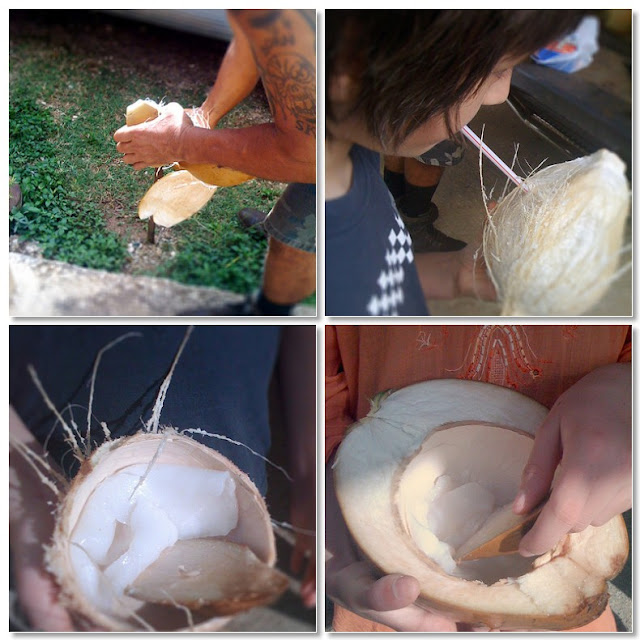How to cut, eat, and drink, a fresh coconut: coconut water, flesh, vegetables salad, fruit salad, rice, and coco-chocolates
Sunday morning Colleen and Charles brought us a bag of fresh coconuts. Of course I had to ask Charles to show me how to open them, and it was easier that I thought (just look at the pictures below). We didn't have any straws so I let the coconut water drip into a glass (getting about three full glasses for each coconut!). We all loved the coconut water, especially if we left the coconut in the fridge: fresh and chilled coconut water!
After drinking the water I got the boys to break the coconuts for me: Dad was good at breaking them, and Max at scraping out the flesh.
When we were in Niue Charles and Colleen came for dinner. Of course I made pasta, but I also made a variety of dishes with the fresh coconuts they brought me the day before. A tomato and coconut salad with cannellini beans, spring onions and olives, dressed with olive oil, lemon juice and sea salt flakes. Coconut rice (just boil the rice with coconut pieces in it, fantastic!), coconut chocolates: I dipped slices of coconut in melted 72% dark chocolate, and also mixed freshly shredded coconut in the remaining chocolate to make choco-coco balls. I made a big tray of these but I forgot to take a photo, se here were the leftovers... and the fruit salad with local papaya, banana, and coconut, a little brown sugar, lemon juice and rum. This I made a few times actually, it was too good! Charles and Colleen couldn't believe how many things I made out of their coconuts, they said that usually the drink the juice and then give the rest to the pigs. They have plenty of coconut. But I guess that for me this was luxury!
So what is a typical dish with coconut in Niue? In the market we tried the local coconut porridge, a warm mixture made with coconut, arrow root and a little sugar. It was different, not bad but not even my breakfast of choice. I preferred coconut bread, which is sold in all the bakeries.
But the best experience for me was to learn how to open and eat coconut at different stages of maturity, so if one day I will be ever stranded on a desert island I will be able to survive... as long as there are coconuts around! On our plantation tour Tony firstly gave us a coconut each to drink, these were very young coconuts and the water tasted different from the one we collected from Charles' coconut. Then Tony opened up some coconuts for us and cut some spoons out of the coconut shells. The younger the coconut the softer the flesh.
I was really surprised to learn that you can also eat coconut when the leaves appear: Tony called it coconut marshmallow, and in fact it was soft (but not as soft as a marshmallow) white and spongy, with a delicate sweet taste, a bit like eating a gigantic soft macadamia nut. This was a favourite with the kids. My favourite was the the stalk of the young coconut plant: Tony peeled and passed it over, crunchy, fresh and a bit like a coconut celery. I have eaten this before, it is called heart of palm, and in Argentina I ate it in sandwiches (it is called palmito there), in Asia I ate it in a variety of dishes, and in New Zealand I went on a foraging trip with a Maori forest ranger and ate the heart of a young Nikau palm (but much smaller than this stalk of coconut!). Nikau heart too taste a little like coconut.
So if you visit Niue make sure that you visit a plantation, the market, or have friends with lots of coconuts, otherwise just stop at your nearest coconut stall.
Photos and Recipes by Alessandra Zecchini ©









Alessandra... mi fai sognare. Grazie per questo report e per le fantastiche foto. Tante volte mi sono chiesta anch'io come utilizzare il cocco nelle mie composizioni... se riuscissi a ritagliare delle forme regolari sarebbe molto più facile. Un bacione, Ale!
ReplyDelete